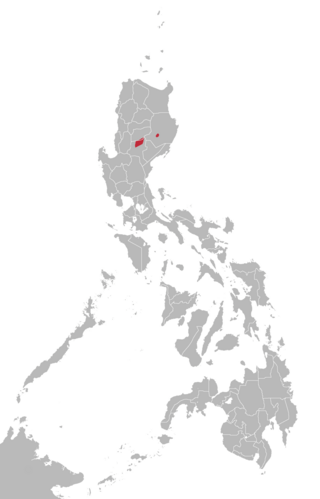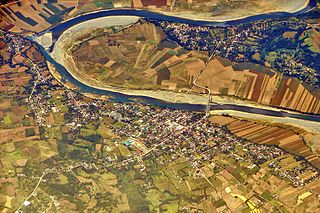
The Cagayan River, also known as the Río Grande de Cagayán, is the longest river and the largest river by discharge volume of water in the Philippines. It has a total length of approximately 505 kilometres (314 mi) and a drainage basin covering 27,753 square kilometres (10,715 sq mi). It is located in the Cagayan Valley region in northeastern part of Luzon Island and traverses the provinces of Nueva Vizcaya, Quirino, Isabela and Cagayan.

Cagayan Valley, designated as Region II, is an administrative region in the Philippines. Located in the northeastern section of Luzon, it is composed of five Philippine provinces: Batanes, Cagayan, Isabela, Nueva Vizcaya, and Quirino. The region hosts four chartered cities: Cauayan, Ilagan, Santiago, and Tuguegarao.

Cagayan, officially the Province of Cagayan, is a province in the Philippines located in the Cagayan Valley region, covering the northeastern tip of Luzon. Its capital is the city of Tuguegarao. It is about 431 kilometres (268 mi) northwest of Manila, and includes the Babuyan Islands to the north. The province borders Ilocos Norte and Apayao to the west, and Kalinga and Isabela to the south.

Isabela, officially the Province of Isabela, is the second largest province in the Philippines in land area located in the Cagayan Valley. Its capital and the largest local government unit is the city of Ilagan. It is bordered by the provinces of Cagayan to the north, Kalinga to the northwest, Mountain Province to the central-west, Ifugao and Nueva Vizcaya to the southwest, Quirino, Aurora and the independent city of Santiago to the south, and the Philippine Sea to the east.
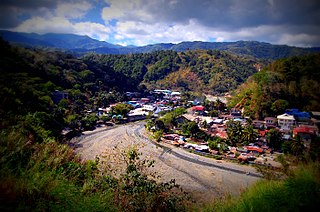
Nueva Vizcaya, officially the Province of Nueva Vizcaya, is a landlocked province in the Philippines located in the Cagayan Valley region in Luzon. Its capital is Bayombong. It is bordered by Benguet to the west, Ifugao to the north, Isabela to the northeast, Quirino to the east, Aurora to the southeast, Nueva Ecija to the south, and Pangasinan to the southwest. Quirino province was created from Nueva Vizcaya in 1966.

The Ibanag are an ethnolinguistic minority numbering a little more than half a million people, who inhabit the provinces of Cagayan, Isabela, and Nueva Vizcaya. They are one of the largest ethnolinguistic minorities in the Philippines.

Bagabag, officially the Municipality of Bagabag, is a 2nd class municipality in the province of Nueva Vizcaya, Philippines. According to the 2020 census, it has a population of 37,985 people.
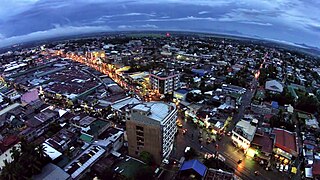
Santiago, officially the City of Santiago, is a 1st class independent component city in the Cagayan Valley region of the Philippines. According to the 2020 census, it has a population of 148,580 people.
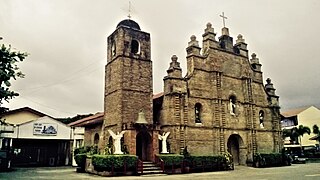
Alicia, officially the Municipality of Alicia, is a 1st class municipality in the province of Isabela, Philippines. According to the 2020 census, it has a population of 73,874 people.

Angadanan, officially the Municipality of Angadanan, is a 3rd class municipality in the province of Isabela, Philippines. At the 2020 census, it had a population of 44,977.

Bayombong, officially the Municipality of Bayombong, is a 1st class municipality and capital of the province of Nueva Vizcaya, Philippines. According to the 2020 census, it has a population of 67,714 people.

Diadi, officially the Municipality of Diadi, is a 4th class municipality in the province of Nueva Vizcaya, Philippines. According to the 2020 census, it has a population of 19,236 people.

Solano, officially the Municipality of Solano, is a 1st class municipality in the province of Nueva Vizcaya, Philippines. According to the 2020 census, it has a population of 65,287 inhabitants..

Villaverde, officially the Municipality of Villaverde, also spelled as Villa Verde, is a 5th class municipality in the province of Nueva Vizcaya, Philippines. According to the 2020 census, it has a population of 20,118 people.

Itawis is a Northern Philippine language spoken by the Itawis people, closely related to the Gaddang speech found in Isabela and Nueva Vizcaya. It also has many similarities to the neighboring Ibanag tongue, while remaining quite different from the prevalent Ilocano spoken in the region and the Tagalog-based Filipino national language.

The Gaddang are a linguistically identified ethnic group resident in the watershed of the Cagayan River in Northern Luzon, Philippines. Gaddang speakers were recently reported to number as many as 30,000, a number that may not include another 6,000 related Ga'dang speakers or other small linguistic-groups whose vocabularies are more than 75% identical.

The Ibanag language is an Austronesian language spoken by up to 500,000 speakers, most particularly by the Ibanag people, in the Philippines, in the northeastern provinces of Isabela and Cagayan, especially in Tuguegarao, Solana, Abulug, Camalaniugan, Lal-lo, Cabagan, Tumauini, San Pablo, Sto. Tomas, Sta. Maria, and Ilagan and other neighboring towns and villages around the Cagayan River and with overseas immigrants in countries located in the Middle East, United Kingdom, and the United States. Most of the speakers can also speak Ilocano, the lingua franca of northern Luzon island. The name Ibanag comes from the prefix I which means 'people of', and bannag, meaning 'river'. It is closely related to Gaddang, Itawis, Agta, Atta, Yogad, Isneg, and Malaweg.
The Cagayan Valley languages are a group of languages spoken in the Philippines. They are:
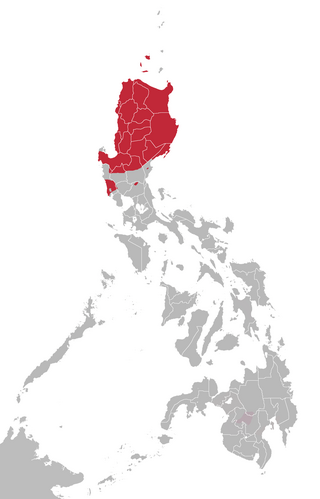
The Northern Luzon languages are one of the few established large groups within Philippine languages. These are mostly located in and around the Cordillera Central of northern Luzon in the Philippines. Among its major languages are Ilocano, Pangasinan and Ibanag.
The "Vizcaya Hymn" is the official anthem of the province of Nueva Vizcaya in the Philippines.
